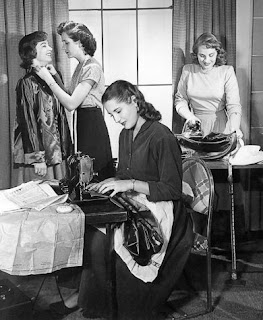 |
Same machines, different year
|
...was an A minus in Sewing. Perhaps I shouldn't have been as upset about that "minus" as I was. It was an elective in 9th grade but a class I loved.
In truth my worst grade was the D in 11th grade Advanced Algebra. I resisted taking Geometry as I was sure I would have little use for it in real life (wrong), and I hadn't done too badly in Algebra I. The teacher, flummoxed that I was the only girl in a room of pocket-protector-wearing, slide-rule-toting boys, and no doubt frustrated by my lack of ability, still gave me a passing grade. I feel sure he didn't want me in summer school.
Back to sewing and 9th grade. I grew up in Shaker Heights, Ohio, a picturesque suburb of Cleveland with an excellent school system. By 1956 the district had outgrown its one junior high (grades 7, 8 and 9). When it became clear the second school would not be finished in time, it was decided to divide the student body and run classes in two shifts. The first shift (mine) ran from 7:20 AM to 12:20 PM.
I am not a morning person now, was not then, and Northeastern Ohio winters come early, stay late, and seem like they are in perpetual darkness. Were it not for Sewing I can't imagine what would have gotten me out of bed that year.
 |
My "school bus", the Rapid Transit
|
I remember no other class. There must have been English, math, some kind of history and science. I remember nothing but that hour spent with Mrs. Finkel and a vintage Singer sewing machine. There was neither gym nor lunch. It's curious we were allowed an elective with such a time crunch of a schedule.
I had taken a semester of Sewing the year before. That and a semester of Home Ec were required for 8th grade girls; the boys took Shop. We made a dirndl skirt, probably the most unflattering silhouette on a 13-year-old, but they were very much in style.
I don't remember everything I sewed in 9th grade. I made a pair of pajamas in a folkloric flannel print trimmed in red rickrack. Wore those for years. Ohio winters, remember? My piece de resistance was a cotton bathing suit and matching skirt in a rosebud print. There must have been quite a few more as the class put on an end-of-year fashion show, and I remember several changes of outfits.
I over-performed homework for this class, spending hours going through fashion magazines to decide on my next project. There were no Jo-Ann's stores then, so shopping for fabric and patterns meant a trip to downtown Cleveland's department stores. If I was flush with babysitting money I might treat myself to a copy of French "Elle" at Schroeder's newsstand on Public Square.
Anyone who sews knows it's tempting to cut corners (sewing pun!). You can cheat a little placing the pattern (especially if you didn't buy enough yardage), disrespecting the grain of the fabric. You will be sorry, but it will be too late. You can skip cutting those notches or ignore instructions to baste before sewing. You can iron the seams as you go or you can iron at the end and hope for the best.
I took no chances! I broke no rules! But Mrs. Finkel gave me an A minus. This was the one and only time I ever questioned a grade, but I had to know why. She was a sweet lady, soft spoken and patient. She had always encouraged my work and praised the results. I was not afraid to speak up.
"Mrs. Finkel," I said. "Why did you give me an A minus and not an A?"
The voice was soft, the eyes were kind. She answered, "Michelle, you never used the electricity."
I had turned the Singer's wheel by hand the entire year. My efforts to make every stitch perfect were my downfall.
Sewing in schools is long gone, but I'm happy to see there are classes offered privately and through the community for youngsters as young as seven. The road to "Project Runway" is a long one but what a highway to heaven!
 |
Urban Stitch Studio in Reno, Nevada
|









